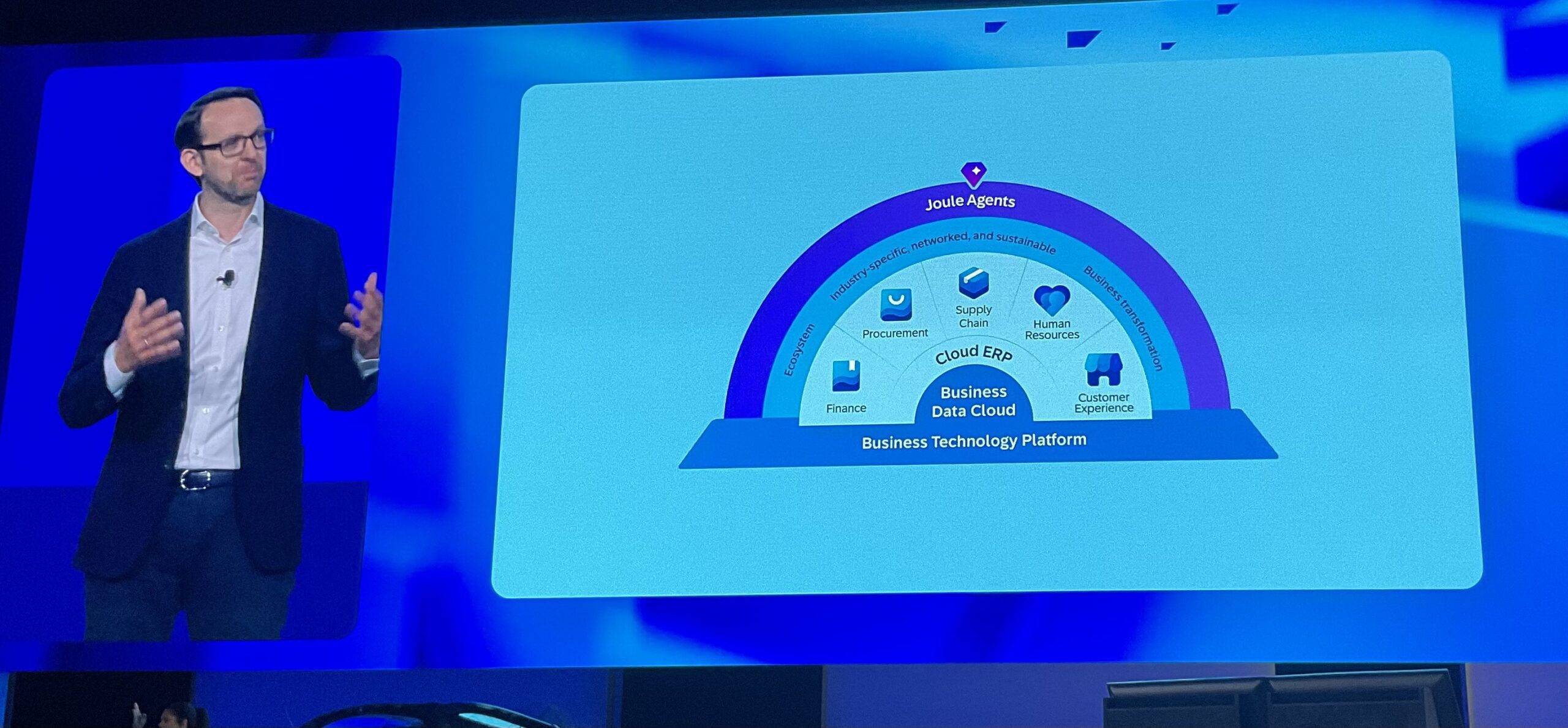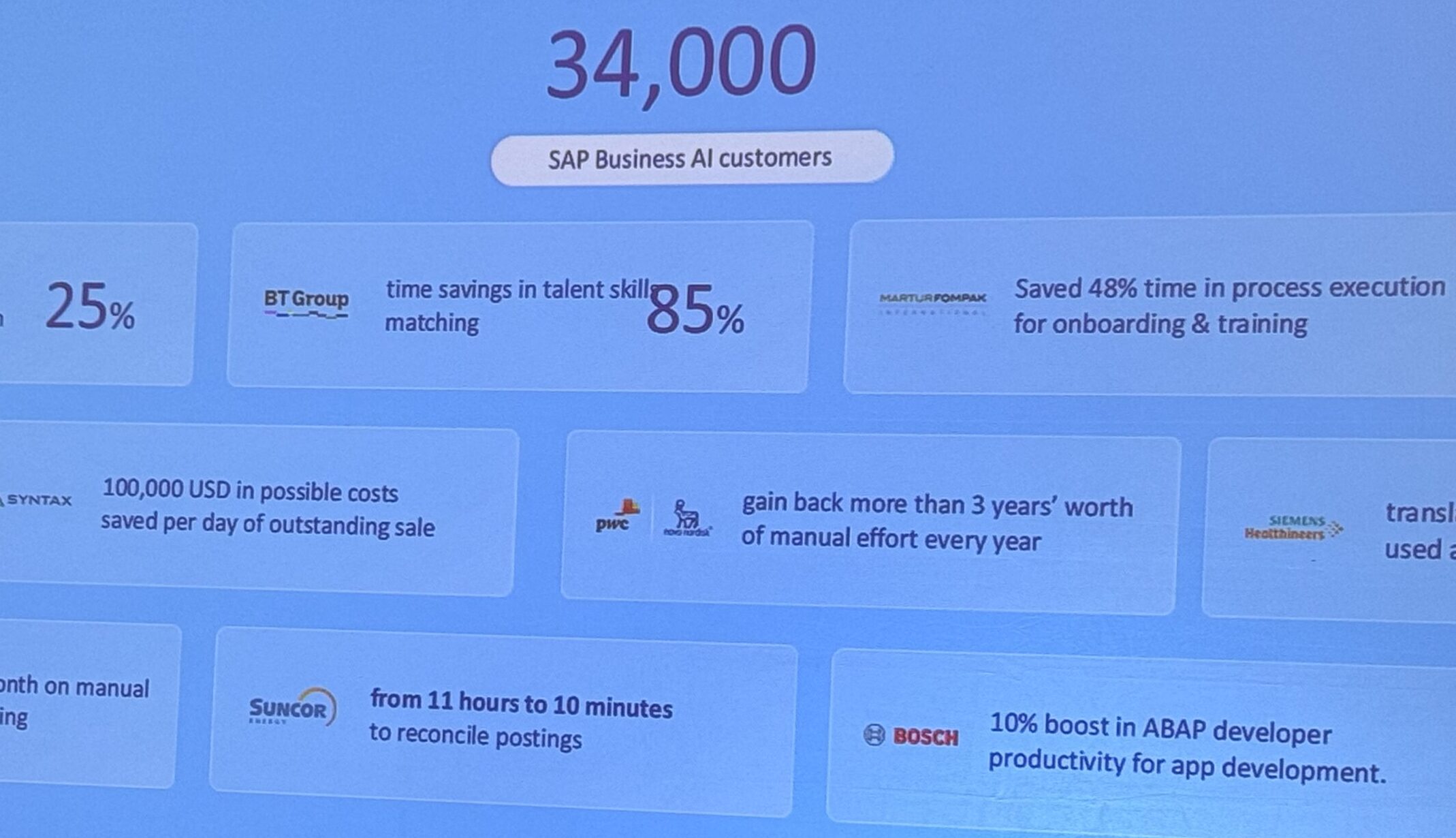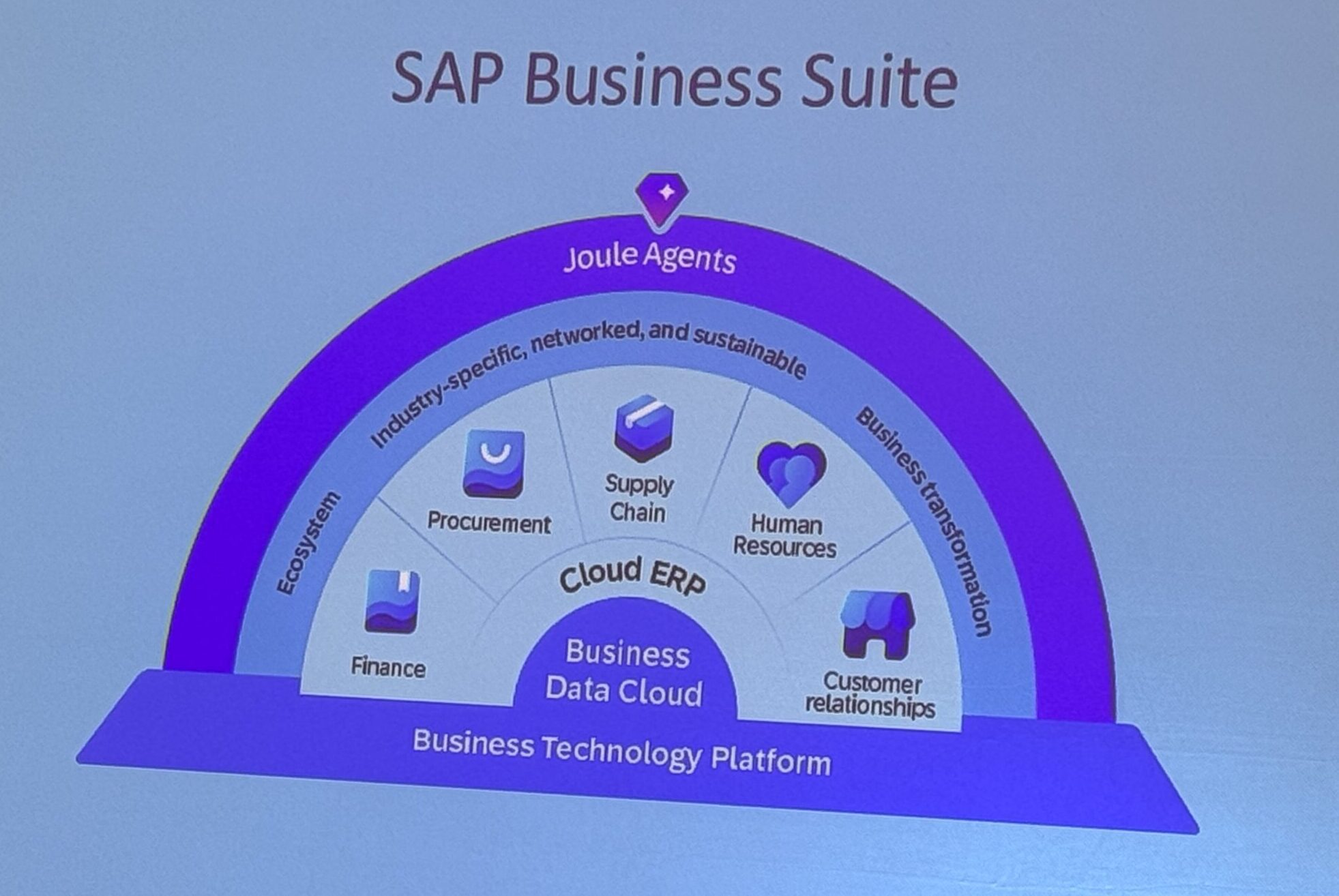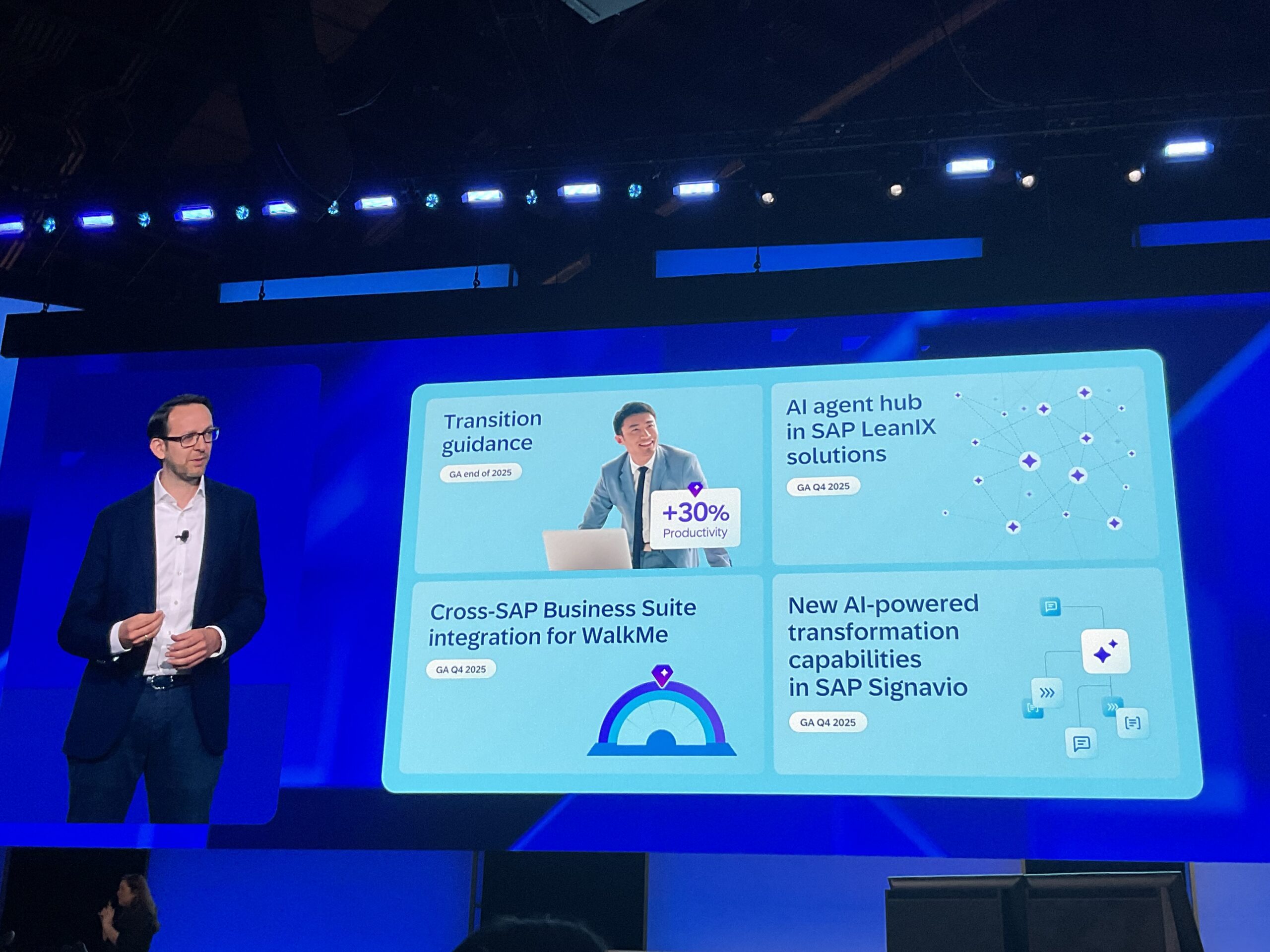SAPPHIRE 2025, which brought together 14k SAP customers and partners in Orlando highlighted SAP’s strategy to support enterprises navigating uncertainty and the accelerating pace of change. Their theme this year: “Your best, made real.” The shift from “Best Run” to “Best Made Real” represents a significant evolution in SAP’s brand strategy and focuses on turning business and technical innovation (e.g. AI) into tangible reality.
SAP message was centered on the foundation for a future-enabled enterprise powered by Applications, Data, and AI working together (aka ‘the flywheel’) and is the core system SAP enables businesses to build for their own operations. This foundation helps businesses gain speed, scale, and strategic value. Building on five decades of experience, SAP is leveraging innovation to support enterprise transformation.
Here are five key insights from SAPPHIRE on how SAP’s offerings enable a business to create and accelerate its own flywheel:
1. SAP’s Integrated Apps, Data, and AI Foundation for the Business Engine
SAP positions the integration of Applications, Data, and AI as a fundamental engine for enterprise transformation. This concept highlights how these three elements, when integrated within an enterprise, can drive value. SAP’s strength has been its integrated approach to core business applications, from ERP to finance, spend management, and HCM. The value of this integration is crucial for new capabilities like AI. SAP’s strategy is to provide this integrated suite, described as “Suite as a Service”, as the foundation. This aims for the suite to become smarter, faster, and more impactful for business operations with every interaction. This vision is presented as credible and currently being delivered.

2. Business Data Cloud (BDC): Building the Data Backbone
Data underpins the Applications and AI in a potential business flywheel. The SAP Business Data Cloud (BDC) is central to SAP’s approach. BDC is described as the backbone, connecting processes across an enterprise and transforming operational data into intelligence for decision-making. Harmonizing data is emphasized; data from various SAP sources, like purchase orders, is standardized into a single representation in BDC. BDC also supports incorporating external data, such as spend data, for a consolidated view, and unstructured data through partnerships like Databricks. This integrated data layer in BDC provides the ‘Data’ component for the business flywheel and is seen as essential for unlocking the potential of AI in operations. SAP offers new data services, including discovery workshops and assessments, to help organizations overcome data challenges and harmonize data models as part of embracing BDC.
3. Embedded Business AI: Enhancing Productivity
AI is a significant component enabling the business flywheel. SAP is embedding AI capabilities within its applications. Plans include growing the number of embedded AI scenarios from over 230 to 400 by June. SAP’s approach, called “Business AI,” is described as real, embedded, human-centered, built on trust, and focused on business outcomes, productivity, and growth. Through an agent framework, SAP enables AI to orchestrate tasks and trigger workflows within business processes. Examples include automating expense filing, managing sourcing, generating work orders, identifying shop floor disruptions, and answering employee questions about pay and policies. The goal is to achieve significant productivity gains, potentially up to 30%, by applying AI end-to-end across workflows. SAP emphasizes that the human remains the final decision-maker in many processes. SAP also introduced the Agent AI Hub as an enterprise tool for customers to manage custom AI agents with governance within their landscape. Partnership with Perplexity and AWS for AI co-innovation was also announced.

4. The Integrated Suite: Providing “Best of Breed as a Suite”
While standalone (“best of breed”) applications can solve specific problems, they have contributed to landscape complexity and fragmented processes. SAP argues that making everything work together becomes exponentially harder. The integrated, harmonized foundation provided by SAP’s reimagined Business Suite is presented as key to unlocking the next wave of productivity for organizations.
SAP advocates for “best of breed as a suite”. This means offering strong capabilities in individual areas (finance, spend, supply chain, HCM, CX) while ensuring they are integrated out-of-the-box for the customer. SAP manages the integration of applications and data harmonization, reducing the burden on customers. This integrated approach is seen as uniquely enabling AI that understands end-to-end business contexts within customer operations and can act across different applications. Examples mentioned include activating lead-to-cash processes integrating Sales Cloud with finance, or connecting procurement processes. This aims to shift value creation “upstream” to the AI side.

5. Integrated Tools and Services: Accelerating Transformation
Adopting an integrated, AI-powered suite requires transformation for organizations. SAP is focused on helping organizations navigate this journey faster and more cost-effectively. An integrated tool chain, including Signavio (process analysis), LeanIX (application management), Cloud ALM (project execution), and WalkMe (user adoption), aims to drive value for customers by reducing transformation costs, accelerating time to value, increasing business agility, and supporting innovation adoption. Using this tool chain can potentially help customers achieve up to a 30% reduction in transformation costs and be 35% faster. AI capabilities are also being integrated into these tools.
The RISE with SAP methodology is evolving to cover the full Business Suite (“fit to suite”) and includes new dashboards, AI capabilities, and transformation preparation services to build tailored roadmaps with customers. SAP is also restructuring its services and support with a tiered approach (Foundational, Advanced, Max) to provide simpler engagement and better support for customers in adopting the SAP Business Suite, Business Data Cloud, and Business AI. These services include helping organizations embrace AI, activate embedded AI use cases, and define holistic AI strategies. The integrated tool chain and services are presented as essential for helping businesses overcome challenges like data quality and realize the value of AI and the integrated suite.

SAPPHIRE showcased SAP’s focus on its Apps, Data, and AI strategy. By providing the Business Data Cloud as the data foundation, embedding AI throughout the suite, offering the integrated “Best of Breed as a Suite” application layer, and delivering integrated tools and services, SAP aims to empower organizations to navigate uncertainty and achieve new levels of productivity and resilience. While challenges exist, the potential value for organizations is presented as significant. The message, echoing a proverb about planting a tree is that the time for transformation, enabled by SAP, is now.
Other research produced from SAPPHIRE, 2025:
SAPPHIRE Keynote Live Discussion with Jon Reed & Josh Greenbaum: LINK HERE
CloudWars Day 1 Recap with Bob Evans: LINK HERE
SAPPHIRE X stream: LINK HERE
Interview with Josh Gosliner, VP of Product Strategy at SuccessFactors on SAP SuccessFactors news: LINK

